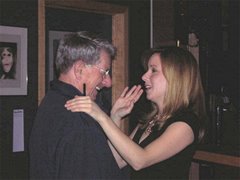Natural, Undyed 100% Wool
I have long had a yen to try my hand at dyeing yarn. I don't like the idea of using chemicals with designated pots and containers and utensils so the process of dyeing with food coloring impressed me as being clean, easy, and worth a try.
There are many websites with detailed instructions on yarn dyeing but
Instructables appealed to me most as I liked the idea of using the microwave.
Prepping The Wool
I had natural, undyed Henry's Attic Kona (100% merino wool) that I had purchased at Gaspereau Valley Fibres a couple of years ago. It came on a large skein and I wound it at the time, using a yarn swift. Today, I had to reverse the process to get it back into skein form again! I tied it loosely in four places, using small pieces from the skein to do so.
Then I set it in the casserole dish and filled the dish with a combination of three parts water to one part vinegar. I let it sit on the counter for the rest of the day.
Before supper, I drained the vinegar water, set the yarn in an empty bowl, and filled the casserole dish again with plain water. I added 1/4 teaspoon of Wilton's Cornflower Blue icing color and one drop of Club House liquid yellow color.
This Is What It Looked Like
I put it in the microwave and zapped it for 3 minutes and 30 seconds. Then, without opening the microwave door, I let it set for 5 minutes. Then repeated the process. The dyeing is complete when the water is clear. Well, my casserole dish is on the large side and there was a lot of wool on the skein (186 grams) so I repeated the process twice more until I was satisfied that the yarn had absorbed the color well and the water was perfectly clear.
Voila! Pretty Blue Yarn!
The website instructions stress that it is important to let the wool cool down naturally and slowly so I left it in the water in the covered casserole dish until late in the evening. Then I drained the dish, gently squeezed the excess water out of the wool, and draped the skein over a plastic hanger and hung it over the shower nozzle so it could drip and dry in the bathtub overnight.
However:
Variegated
When fully dry, the yarn was very pretty, but it was decidedly variegated. I had hoped for solid or, at least, a semi-solid blue. There were still short drifts of natural colored yarn along the skein. I think this may have been because the dish was too small for the hank of yarn so the fiber did not have a chance to spread out and pick up the color evenly. And unless I wound some and tried a sample right away, there was no way of telling if a piece would knit up stripey or splotchy, just plain pretty, or just plain weird.
This morning, I thought long and hard, and decided to redye it. Knowing that a lot of the blue could get much darker, I preferred to chance it as opposed to leaving so many undyed natural colored portions.
This time, because I did not have a larger dish for the microwave, I went to
pieknits' blog, and followed the instructions for dyeing yarn on the stove top. My stock pot is much larger than the casserole dish so the yarn would be able to spread out more.
Interestingly, and hard to get my head around at first, is the fact that the amount of water does not affect the depth of color. It is the ratio of dye to yarn quantity! I just felt I need more water for circulation.
I used the same cornflower blue with a drop of yellow formula. This time, the yarn was placed in tepid water and the dye was added after being premixed in a cup of hot water. It is brought up to 160 degrees F.and allowed to simmer for 10 minutes. Then the temperature was raised to 180 degrees F. and it simmered for 30 minutes. After cooling to room temperature, I drained it, and rinsed with room temperature water and hung it to dry.
I actually think my first attempt resulted in a slightly prettier, softer toned yarn but this one is closer to the semi-solid I was looking for. Gone are the plain white sections and the entire skein is varying depths of blue. Even though I often knit with them and enjoy them, sometimes I get tired of variegated yarns with flecks or stripes of different colors. I am in a solid or semi solid phase!
And I had lots of time between stages to put together a spinach manicotti for supper!






